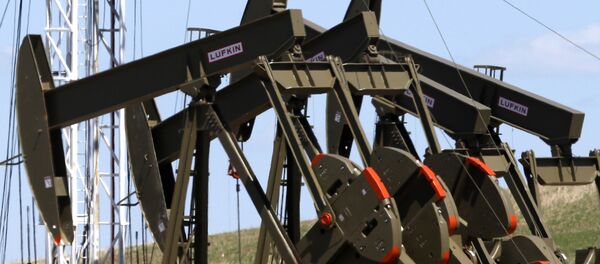MOSCOW (Sputnik) — On Monday, US West Texas Intermediate (WTI) crude and Brent crude futures tumbled to a 12-year low amid the continued oil price slump that saw Brent crude prices plunge from $115 per barrel to $48.5 per barrel between June 2014 and January 2015, hitting the lowest levels since 2004 by January 2016.
The following day, prices dipped even further before slightly recovering. US West Texas Intermediate (WTI) crude futures briefly tumbled by over 4 percent, falling briefly to $29.96 a barrel, the lowest value in 12 years, and returned to $30.13 per barrel by 19:15 GMT.
"About 85% of our production is profitable at levels between $35 and $40 per barrel. There may be weeks that the price drops below $30, but I would be surprised if that lasted for very long, especially once refineries gear up for the spring and summer driving seasons," Director of the Environment and Natural Resources Program at the Belfer Center for Science and International Affairs at Harvard University, Henry Lee, told Sputnik.
However, with the US oil industry's overcapacity at approximately 6.5 million barrels per day, a figure set to increase by 2017, the United States may see further reduction in production levels, Lee noted, adding that an estimated half of the oversupply had already been shut in.
Small companies are set to be the primary casualty of the oil price tumble, a professor of Petroleum and Natural Gas Economics at the University of Wyoming pointed out.
"I do think a number of smaller players will find themselves in financial trouble in the coming days… I suspect a number of firms will have trouble meeting debt obligations… I suspect the cost of extracting a barrel of oil is somewhere in the mid-$20 range for a goodly number of firms… The implication is that such firms won't even be able to cover their variable costs, given the present situation in the oil market," Charles Mason told Sputnik.
The one third of oil companies vulnerable to going bust may well shut production, Mason said, stressing that the market share of these smaller players is not likely to be significant. At the same time, small companies working in the shale oil industry are most exposed to the risk, he added.
"The drop in oil prices is almost surely tied intimately to the downturn in the Chinese economy. Unless there is a solid recovery in Japan and Europe, I suspect the problems with the Chinese economy will keep oil prices from recovering for a while," Mason highlighted.
The oil price free-fall triggered fears of mass US oil company bankruptcies, with reportedly over 30 US oil companies, which collectively owe $13 billion, having already filed for bankruptcy protection. A recent report by Wolfe Research indicated that as many as a third of American upstream energy companies could go bankrupt or face restructuring by mid-2017.
According to a recent IMF forecast, global oil demand is set to slump particularly due to a projected continuation of the economic slowdown in China. Manufacturing surveys showed China's factory activity contracted at a sharp pace in December 2015, forcing China's authorities to revise 2016 growth targets.





